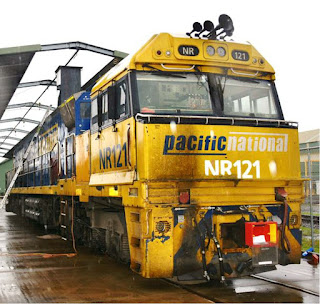The New South Wales Environment Protection Authority commissioned a study in 2014 on the emissions and efficiency of diesel locomotives in use by Pacific National - "DIESEL LOCOMOTIVE Fuel efficiency & Emissions Testing".
 |
| Pacific National Diesel-Electric Locomotive NR121 |
The test report includes the electric power output of the diesel engines used in the testing program, and the quantity of fuel needed for operating the locomotives between Melbourne and Brisbane.
This data allows the calculation of the output and storage capacity of a grid scale battery that, if installed in a rail car, would replace the diesel engine, electric generator, and diesel fuel used by Pacific National's diesel locomotives.
The financial analysis - to choose the time for conversion from diesel to battery power - is a separate matter. When the business case favours the conversion will depend on the falling cost of grid-scale energy storage options and the security of diesel fuel supplies. It is only a matter of time. That is to say it is a question of "when", not "if", the conversion is a good financial proposition.
The energy requirements.
Two Pacific National diesel locomotives are described in the report for the NSW EPA.
Each had diesel electric power output of between 3,000 and 3,500 kilowatts - about 3.5 MW.
The fuel capacity was 12,500 litres of diesel fuel - sufficient for operating from Melbourne to Brisbane without refuelling.
The fuel consumption was about 210 grams of diesel for each kWh generated.
Diesel has a density of about 0.85 kilograms per litre. See "2.3.5 Diesel Fuel".
With a few calculations - 12,500 litres of diesel weigh 10,625 kgs.
At 210 grams per kWh, 10,625 kgs of diesel can generate a little over 50,000 kWh or 50 MWh of electrical energy.
A grid-scale energy storage unit able to deliver 4 MW of output power with 50 MWh of storage capacity is in the range of Battery Energy Storage Systems currently being delivered be energy storage manufacturers.
See for example - "In New York, a high-level demonstration project is using a 4 MW / 40 MWh battery storage system..." reported in Battery Storage Paves Way For a Renewable-Powered Future
The Business Case.
Pricing information and other details required for a financial analysis and business case for converting Pacific National's diesel locomotives to battery energy storage systems for the time being is not easily obtained.
Some indicative estimates can be calculated -
- 12,500 litres of fuel are loaded for a single trip from Melbourne to Adelaide. At $1 per litre, the fuel costs $12,500.
- Electrical energy for the trip is 50 MWh. At $50 per MWh, the energy cost would be $2,500 - a saving of $10,000 per trip. If 200 trips were made each year, the fuel saving would be $2 million per year.
If it is physically not practical to use a 50 MWh Battery Energy Storage System due to its size and weight, this could explain the interest in development of hydrogen with fuel cell technology for rail transport. See "Coradia iLint™ – the world's 1st hydrogen powered train" -
It was at InnoTrans 2016 in Berlin that Alstom presented the Coradia iLint™ for the first time. The launch of the CO2-emission-free regional train that represents a true alternative to diesel power positioned us as the first railway manufacturers in the world to develop a passenger train based on hydrogen technology. And just two years later, at 2018, the iLint™ entered into commercial service in Germany.
Further Reading.
A recent research paper provides a summary of weight and volume characteristics of energy storage systems for potential application in rail transport - "Energy storage devices in electrified railway systems: A review"

0 comments:
Post a Comment